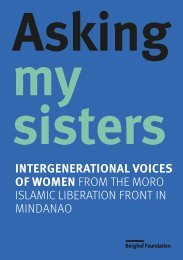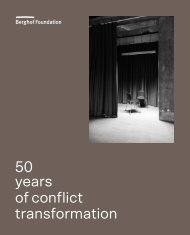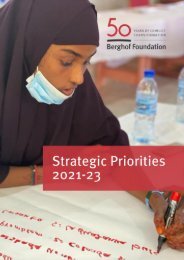Berghof Glossary on Conflict Transformation
The Berghof Glossary on Conflict Transformation presents 20 of the main principles and approaches used by the Berghof Foundation in its work. It is a concise and accessible exploration of what it takes to create “space for conflict transformation”. 2019 edition.
The Berghof Glossary on Conflict Transformation presents 20 of the main principles and approaches used by the Berghof Foundation in its work. It is a concise and accessible exploration of what it takes to create “space for conflict transformation”. 2019 edition.
You also want an ePaper? Increase the reach of your titles
YUMPU automatically turns print PDFs into web optimized ePapers that Google loves.
Fostering Human Security<br />
HUMAN SECURITY | a comprehensive, people-centred and preventi<strong>on</strong>-oriented<br />
c<strong>on</strong>cept that includes protecti<strong>on</strong> from threats<br />
in the area of ec<strong>on</strong>omic, food, health, envir<strong>on</strong>mental, pers<strong>on</strong>al,<br />
community and political security.<br />
The erosi<strong>on</strong> of the traditi<strong>on</strong>al understanding of security<br />
There are countless examples throughout history where seeking<br />
“security” has served to justify wars and raids, c<strong>on</strong>quering<br />
col<strong>on</strong>ies and oppressing peoples. Security policy was a zero-sum<br />
game played according to the law of the str<strong>on</strong>gest, with security<br />
of the powerful being based <strong>on</strong> the insecurity of the less powerful.<br />
This narrow understanding of security – sovereignty and<br />
protecti<strong>on</strong> of states – was called into questi<strong>on</strong> when humankind<br />
entered the nuclear age.<br />
Since any use of nuclear weap<strong>on</strong>s harbours the risk of unc<strong>on</strong>trollable<br />
devastati<strong>on</strong>, it was the interdependence of security, between<br />
the “haves” and the “have-nots”, which became a political<br />
issue. A deep understanding of this new dimensi<strong>on</strong> of threat,<br />
and of the resp<strong>on</strong>sibility of social and natural scientists to work<br />
together to find ways of better dealing with c<strong>on</strong>flict than weap<strong>on</strong>ised<br />
security, was an important impulse for the founding of the<br />
<str<strong>on</strong>g>Berghof</str<strong>on</strong>g> Foundati<strong>on</strong> for C<strong>on</strong>flict Studies in the 1970s.<br />
Growing awareness of nuclear interdependence has also helped<br />
to carve out a growing c<strong>on</strong>sciousness that security is no l<strong>on</strong>ger<br />
just a military issue or privilege <strong>on</strong>ly of states. Rather, structural<br />
interdependences may also exist because of other – n<strong>on</strong>military<br />
– risks or threats to physical existence and between<br />
unequally powerful social actors in c<strong>on</strong>flict, such as between<br />
dysfuncti<strong>on</strong>al governments and an organised oppositi<strong>on</strong> in fragile<br />
states. Structural interdependence and power asymmetries<br />
may thus become a str<strong>on</strong>g driver of interests in → C<strong>on</strong>flict Transformati<strong>on</strong>.<br />
87










